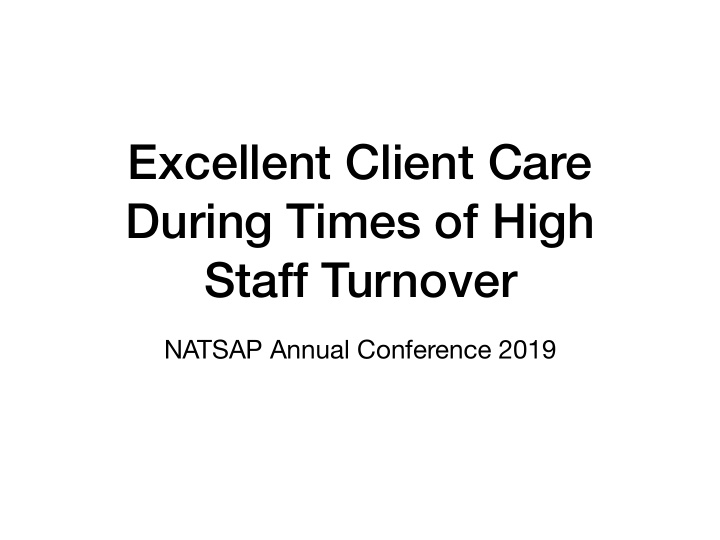



Excellent Client Care During Times of High Staff Turnover NATSAP Annual Conference 2019
What is essential? Less is more
(Lost productivity + Hiring + Onboarding + Development + Unfilled Time) X (Number of Employees X Annual Turnover Percentage) = Annual Cost of Turnover Annual turnover percentage under 10-12% is good
Center for American Progress: There are Significant Business Cost to Replacing Employees by Heather Boushey and Sarah Jane Glynn
Annual Salary Hourly Rate Turnover Cost Annual Cost $20,000.00 $9.42 16.1% $3,220.00 $25,000.00 $11.77 16.1% $4,025.00 $30,000.00 $14.12 16.1% $4,830.00 $35,000.00 $16.48 16.1% $5,635.00 $40,000.00 $18.83 16.1% $6,440.00 $45,000.00 $21.19 16.1% $7,245.00 $50,000.00 $23.54 19.7% $9,850.00 $55,000.00 $25.89 19.7% $10,835.00 $60,000.00 $28.25 19.7% $11,820.00 $65,000.00 $30.60 19.7% $12,805.00 $70,000.00 $32.96 19.7% $13,790.00 $75,000.00 $35.31 20.4% $15,300.00
Burnout & High Turnover • Low pay • Demanding work conditions • Lack of recognition in the value of their work • Lack of input in important decisions • Physical, mental and emotional exhaustion Source: Sta ff Perceptions and Experiences at a Residential Treatment Center, Miranda Ochoa (2012)
Burnout & High Turnover https://www.casey.org/turnover-costs-and-retention-strategies/
Generational Differences
Traits of Top Staff Members
People Change People’s Lives
Excellent Team Members • Show up ready to work • Relational w/ boundaries • Follow Medication Protocol • Feedback to clients • Feedback of clinicians • Intuitive • Support program • Team Oriented • Trust the process
The other 23 hours
Recruiting
Rate - Nov North Carolina 3.6 22 State Rank 2018 Tennessee 3.6 22 Hawaii 2.4 1 Montana 3.7 26 Iowa 2.4 1 Texas 3.7 26 New Hampshire 2.5 3 Delaware 3.8 28 Idaho 2.6 4 Rhode Island 3.8 28 Vermont 2.7 5 Michigan 3.9 30 New York 3.9 30 Minnesota 2.8 6 Oregon 3.9 30 Nebraska 2.8 6 Alabama 4 33 North Dakota 2.8 6 Maryland 4 33 Virginia 2.8 6 New Jersey 4 33 Missouri 3 10 California 4.1 36 South Dakota 3 10 Connecticut 4.1 36 Wyoming 4.1 36 Wisconsin 3 10 Illinois 4.2 39 Kansas 3.2 13 Pennsylvania 4.2 39 Utah 3.2 13 Washington 4.3 41 Colorado 3.3 15 Nevada 4.4 42 Florida 3.3 15 Kentucky 4.5 43 Oklahoma 3.3 15 New Mexico 4.6 44 Ohio 4.6 44 South Carolina 3.3 15 Arizona 4.7 46 Maine 3.4 19 Mississippi 4.7 46 Massachusetts 3.4 19 Louisiana 5 48 Georgia 3.5 21 West Virginia 5.2 49 Arkansas 3.6 22 District of Columbia 5.6 50 Indiana 3.6 22 Alaska 6.3 51 https://www.bls.gov/web/laus/laumstrk.htm
How do you find your staff • Online (Indeed, Monster) • Online (Craigslist, social media) • Word of mouth • Sta ff bonus • Job fairs
Job postings are for candidates not employers • Can they understand the job? • Can they picture themselves doing the job? • What appeals about the job? • Media rich • Aid their curiosity • Searchable
Hiring
Are they a fit? • Skill set • Culture • Personality • Maturity • Emotional health
What other careers would be good indicators of success?
Hiring Best Practices • Team input • Visitation • Interview • Observe in other settings • References • Snooping
Onboarding
Standard Onboarding 30 22.5 15 7.5 0 1 2 3 4 5 6 7 8 9 10 11 12
Progressive Onboarding 30 22.5 15 7.5 0 -2 -1 1 2 3 4 5 6 7 8 9 10 11 12
Pre-start • Parking • Dress code • Necessary Forms/Documents • General plan for first week • Food
Orientation • People • Place • Culture • Treatment
Overconfident
Under-confident
Levels of Communication Silent Listening You Are Capable Questioning Paraphrasing Empathizing Supporting Analyzing Evaluating Advising You Need Me Adapted from Tim Alexander’s summary of: Adler, Ronald B., Lawrence B. Rosenfeld, and Russell F. Proctor. Interplay: The Process of Interpersonal Communication . New York: Oxford UP, 2004. Print.
Training • Mentor • Systems • Interpersonal • De-escalation • Team process
Development • Continued Eduction • Exposure to behind the scenes • Special Projects
Probation Ends • How do you know if it isn’t a fit?
Retention
Pay
Advancement
Continuing Development & Growth
NEXT STEP ▸ Email Follow-up ▸ NATSAP to 44222 ▸ chuck@projectpatch.org
Chuck Hagele - chuck@projectpatch.org Colleen Donald -cdonald@projectaptch.org
Recommend
More recommend